
We are starting the publication of a series of articles by renowned Japanese aviation expert Nick Millman. In them, Nick will provide information on the differences between the various production versions of the Nakajima Ki-43 II Hayabusa fighter, with particular emphasis on the versions that can be built using the Arma Hobby kit. Also, as a modeller, he will not neglect the question of painting and marking of these aircraft.
Together with Nick, we will try our best to illustrate this rather complicated article with photos and drawings, which is not easy – Japanese photos in good quality for which publication rights can be obtained are not widely available….
We invite you to read Nick Millman’s article!
2nd version of the “Falcon”
Development production of the Nakajima Type 1 Model 2 Fighter (Ki 43-II Hayabusa – “Peregrine Falcon”), Allied code name ‘Oscar’, began in parallel with continued production of the Model 1 (Ki-43-I) in February 1942. The development programme was essentially the replacement of the Ha-25 engine with the improved Ha-115 but other improvements and changes were made throughout the production run.
Ki-43 I assembled from parts of several captured aircraft by the Technical Air Intelligence Unit and tested at the famous 7th Hangar of Eagle Farm airbase in Brisbane, Australia. Visible typical I version two-blade propeller, longer wing, telescopic sight and smaller, flattened canopy
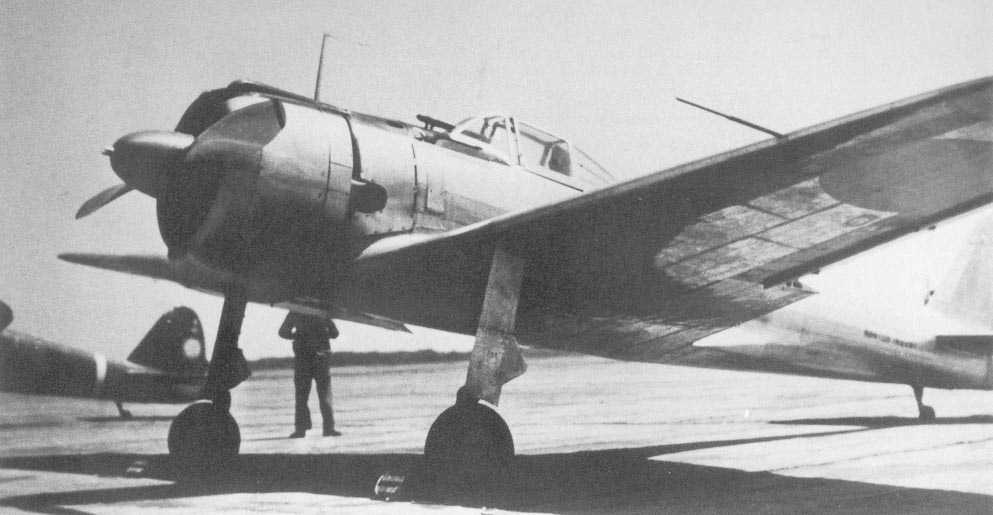
Another Ki-43 I – clearly visible telescopic sight and flat top of the canopy

Ki-43 I – visible annular oil cooler behind two-blade propeller
By the end of 1942 a total of 75 Model 2 aircraft had been produced with coded production numbers (seizô bangô – p/n) from 5001 to 5075. During the same year a total of 541 Model 1 aircraft were produced with coded production numbers from 271 to 811. The last Model 1 aircraft was produced in February 1943 with production number 816.
The first “IIs”
The first 153 Model 2 aircraft retained the long wing of the Model 1 and the annular oil cooling matrix within the cowling.
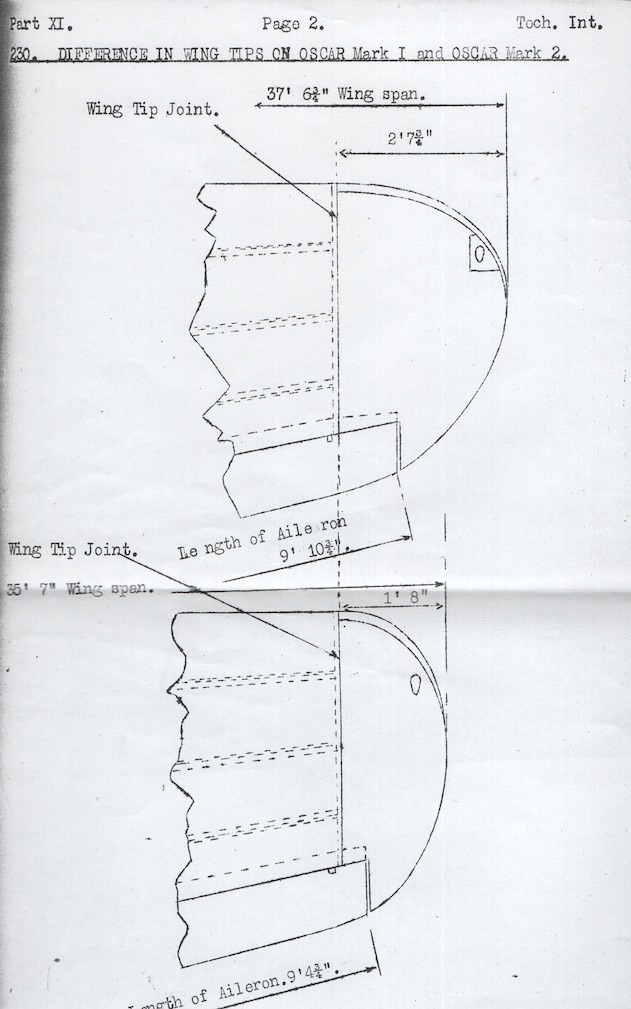
Technical drawing showing the difference in the wingtips of versions I and II. The first version II aircraft still had long wings like version I
The oil cooler intake beneath the cowling was smaller and of different shape to the later type and the canopy was re-designed to a slightly larger and more curved form than the flat topped original. The armament of the Model 1 Hei was also retained, being the twin cowling mounted 12.7mm Ho-103 designated as ‘machine cannon’. The tubular, optical gunsight was replaced with a reflector-type gunsight. The shorter wing Model 2 was introduced with p/n 5154 and during 1943 improvements to armour protection for the pilot and also ‘bullet proofing’ of the fuel tanks were introduced.

Early II – behind propeller visible annular oil cooler as in version Ki-43 I. Small headrest, small air intake under engine
How to recognise them?
In Burma the short wing Oscars introduced in the autumn of 1943 were at first identified as ‘Hamps’ (editor’s note: Mitsubishi ‘Zero’) and surprisingly not correctly identified by Allied intelligence until March 1944:-
‘Recent information from Technical Intelligence has now settled satisfactorily the question of the fighters in Burma with ‘square wing tips’ . It will be recalled that over a period these fighters have been constantly reported as HAMPS presumably because of the common characteristic of wing tips. Attention has been drawn previously in this section to two points in connection with this type of aircraft:-
a. Its arrival in any strength coincided with the arrival of a newly equipped fighter unit
b. The possibility of it being a new type of Army Air Force fighter
It has now been established that this is the final development of Type 1 Fighter OSCAR Mark 2 which has reduced wing span with blunt, rounded wing tips and this may give the false impression of HAMP. This new type of fighter has been identified since the withdrawal recently of some fighter strength and a reasonable assumption is that OSCAR Mk 2 will for the present form part of the normal replacement to fighter units and number of fighters in theatre.’
(From HQ SEAC Weekly Intelligence Summary # 16 of 5 March 1944)
A 1943 instructional film is available in the collection of the Australian War Memorial, with which Allied airmen were trained to recognise the silhouette of earlier versions of the Ki-43 Hayabusa. It is worth noting that the aircraft depicted in the film is heavily simplified.
Secrets of nomenclature
The Ko, Otsu, etc., suffix designations, sometimes rendered as a, b, c, etc., in English sources, were usually used by IJAAF to denote armament variations in fighters. As the Ki-43-II carried an identical armament of 2 x Ho-103 12.7mm machine cannon throughout its service these suffixes are not historically accurate. The detail differences in the II series were production changes to the airframe and engine. In Japanese references those sub-types are often divided by features into early, mid and late production types with the so-called II Kai as a final type, all using the word ki (期) which means period but is sometimes given as ‘production’ in English. Thus:-
- 初期 – (hatsu ki) = first period (Ki-43-II with annular oil cooler and long Ki-43-I wingspan)
- 中期 – (naka ki) = middle period (Ki-43-II with enlarged under cowling cooler and shortened wingspan)
- 後期 – (nachi ki) = later period (Ki-43-II with rearwards thrust exhaust stacks and landing light in port wing leading edge)
- 末期 – (matsu ki) = end or final period (this is the Ki-43-II Kai with individual exhaust stacks)
 Ki-43 II from the middle period. Exhaust tube pointing to the side. Pilot’s headrest completely removed (an individual feature of a specific aircraft, occurred on all versions)
Ki-43 II from the middle period. Exhaust tube pointing to the side. Pilot’s headrest completely removed (an individual feature of a specific aircraft, occurred on all versions)
 Ki-43 Ki-43 II of the late period. Rear-facing exhaust tubes, large headrest, fuel tanks suspended outside the undercarriage legs on universal pylons (both tank or bomb could be slung on these)
Ki-43 Ki-43 II of the late period. Rear-facing exhaust tubes, large headrest, fuel tanks suspended outside the undercarriage legs on universal pylons (both tank or bomb could be slung on these)
Other differences
Only the main features of each sub-type are remarked above but not all the many small additional detail changes. The Arma Hobby Ki-43-II can be built as a mid-production or late-production Ki-43-II with most detail changes provided in the kit as optional parts.
There are actually four distinctively identifiable versions of Ki-43-II prior to II Kai with one researcher referencing designations of Ki-43-IIa early, Ki-43-IIa late, Ki-43-IIb early and Ki-43-IIb late. This divides the mid-production aircraft into IIa late and IIb early focussed mainly on the change from outward facing to rear thrusting exhausts but also incorporating the larger, armoured headrest. In addition the late production aircraft moved the wing racks for the drop tanks from inboard of the undercarriage to outboard. The Army Air Headquarters (Koku Hombu) Table of Aircraft Designations and Armament of 9 December 1943 makes no such distinctions of Ko, Otsu, etc., for the Ki-43-II, omitting any reference to armament for Hayabusa and simply using the single designation Ki-43-II for improvements to armour and bullet proofing, listing these as production number changes.
The Armour
Armour for the Hayabusa pilot was introduced tentatively with a single 12mm plate from p/ n 5520 in June 1943 and definitively with two 12mm plates from p/n 5866 in September 1943, the latter probably coinciding with introduction of the larger armoured headrest. Bullet proofing of fuel tanks was introduced with p/n 5666 in July 1943. These changes were looked upon favourably by units in Burma with specific mention of production numbers and a post-combat report that in one 20 January 1944 encounter with RAF Spitfires a Hayabusa returned to base safely with 39 hits. The Spitfire pilots had claimed seven Oscars destroyed, with eight probables plus eight damaged. Actual Japanese losses were three in total from the 50 and 204 Sentai, one described as ‘self destroyed’. The RAF combat reports describe Japanese fighters, when attacked and hit, flipping over and diving steeply (split-essing) ‘out of control’, emitting brown or white smoke. None of the reports describe seeing crashes although Army units later reported locating two Oscar crashes. The hits were mostly described as flashes with pieces coming away in some cases. It appears that the the Oscars were being hit but then evading and escaping like the one surviving with 39 hits!
Production at Tachikawa factory
Tachikawa had begun production of the Ki-43-II in May 1943 with 99 aircraft from p/n 15001 to 15199 manufactured that year. Bullet proofing of the fuel tanks was introduced from p/n 15031 in August of that year and a single 12mm armour plate for the pilot from p/ n 15150 in December. An additional 12mm armour plate, presumably the larger armoured headrest, was introduced from p/n 15351 in March 1944. Tachikawa produced a total of 703 Ki-43-II during 1944 with parallel production of the Ki-43-III beginning in July of that year from p/n 7001 to 8727 for a total of 1,727 of that variant.
Final production variant of the Ki-43-II was the so-called Ki-43-II Kai (for kaizou – 改造 meaning remodelled or reconstructed) which was fitted with separate rear thrusting exhausts and in some cases water methanol injection. The first example was constructed in April 1944 and production of this type is presumed to have continued until the Ki-43-II line was terminated in September 1944 with the last 11 examples. Tachikawa began production of this type as Ki-43-III with a slightly different configuration of the exhausts and water methanol as standard.
 Ki-43 II from the final production period – large armoured headrest and individual exhaust tubes
Ki-43 II from the final production period – large armoured headrest and individual exhaust tubes
An attempt to improve the armament of the Ki-43-III was explored by Tachikawa with p/n 7884 and one other completed as experimental aircraft. These had a lengthened fuselage forward of the windscreen and the fitting of two 20mm Ho-5 cannon. However this experimental armament arrangement was not introduced in series production. Further discussion of Hayabusa armament issues will be included in Parts Two and Three of this series of articles.
Notes on Camouflage
The Ki-43-II was delivered to the Army unpainted except for an anti-glare panel painted in Black Indigo colour # 32 Koku Ran Shoku – 黒藍⾊ but often just described as ‘black’, a dark brown painted spinner and prop together with silver or grey doped flying surfaces – ailerons, elevators and rudder. Lt Moritsugu Kanai of Hiko Dai 25 Sentai described the prop blades on his Ki-43-II ’05’ as painted dark brown on the front but black on the rear faces.
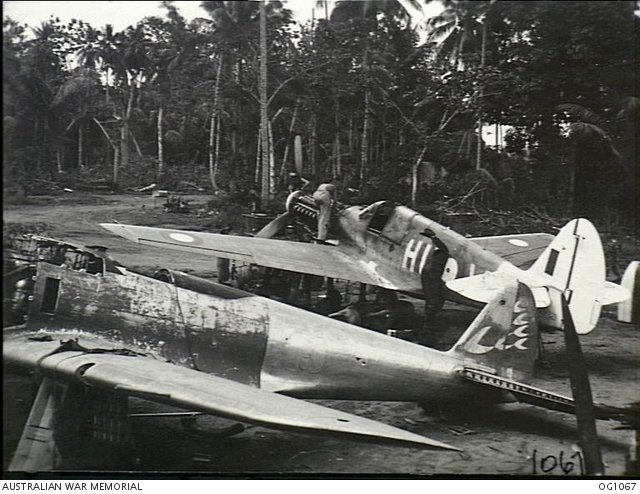
Late production Ki-43 II wreckage with visible landing light hole on wing. Well visible indigo-black anti-glare panel also behind the the cockpit
The first expedient application of green mottles or blotching over bare metal had been seen on some Ki-43-I aircraft of Hiko Dai 11 Sentai moving to the New Guinea theatre. In January 1942 the Army Air Technical Institute had suggested that a single dark green colour was considered suitable for the Southern Front, to be applied by Army Depots before delivery to units, but in practice the extent of camouflage painting depended on the availability of paint and time, as well as the urgency of re-supply, resulting in a wide diversity of schemes and colours.
 Ki-43 II from 3rd Chutai, 59 Hiko-Sentai in flight over New Guinea, turn 1943-1944. Dark green camouflage painting
Ki-43 II from 3rd Chutai, 59 Hiko-Sentai in flight over New Guinea, turn 1943-1944. Dark green camouflage painting
For example those Oscars encountered on 15 and 20 January 1944 in Burma were described variously by the Spitfire pilots as ‘brilliant silver with wavy green lines sprayed over them, like moss on a bright stone’ (probably 64 Sentai) ‘brightly polished with a green mottle on reddish-brown background’ (probably 50 Sentai) ’dark green’ (?) and ‘light grey with red ‘meat-balls’ and what appeared to be dark red blobs, six inches in diameter, on the upper surfaces’ (possibly 204 Sentai). In the late summer of 1944 Koku Hombu directed that the factory painting of single-engined fighters would resume with a standard, solid upper surface finish of Ohryoku # 7 Go shoku (Yellow green # 7 colour) similar to US olive drab and sometimes described in older sources as ‘latewar brown’. Nakajima do not appear to have applied factory paint to their remaining Ki-43-II production but Tachikawa introduced it immediately or very quickly for the Ki-43-III.
Look out for forthcoming further detailed discussion of Hayabusa schemes and colours at Nick Millman’s blog:
http://www.aviationofjapan.com
Check also:
- Buy 1/72 Ki-43 Hayabusa kit online at Armahobby.com!
Ki-43 II Hayabusa w skali 1/72 – zawartość pudełka modelu 70078
Virtual Editor, guest post publisher. When blog authors fall asleep he works unnoticed to improve website content quality.
This post is also available in:
 polski
polski



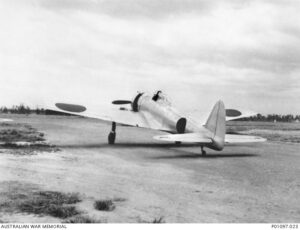
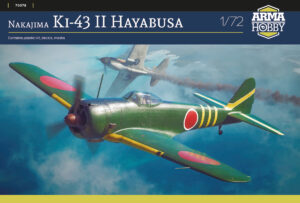
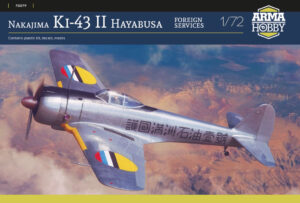
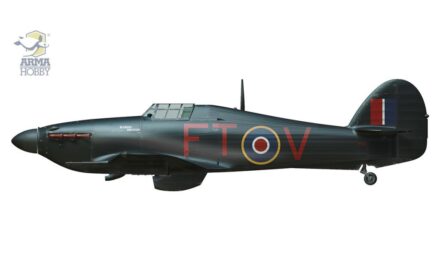
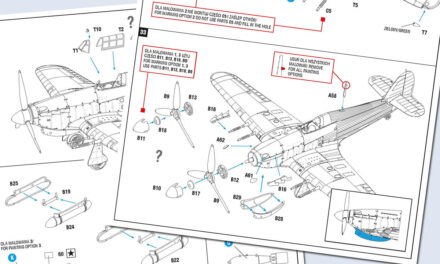
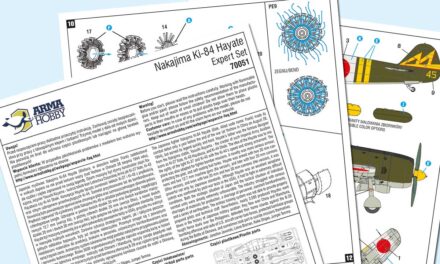
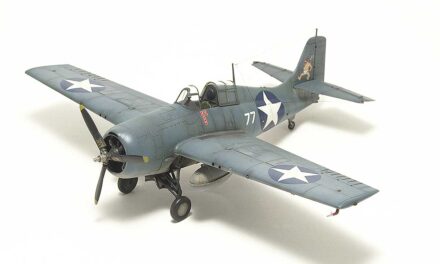
Pretty interesting to read how the Ki-43, which itself is a little overlooked sometimes, had it’s own micro-cosmos of camouflages depending on different units. I’d be curious to know if any particular thought went into why certain Sentai chose their particular type of camo.